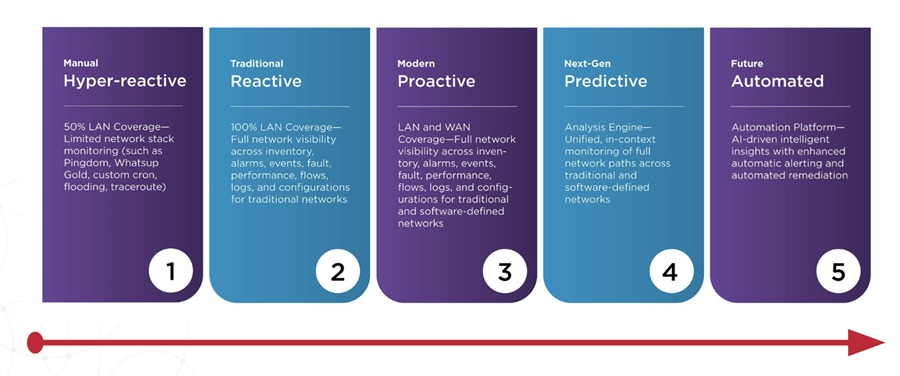
The role of the CIO and IT department is more closely aligned than ever to business operations. Their scope of responsibility is growing and becoming more tightly meshed to core business objectives, which include driving innovation, delivering better customer satisfaction levels, increasing workforce productivity, and reducing bottom line costs.
From first-hand conversations with customers and my commercial and technical teams, I am constantly hearing the common theme that organizations want to make their IT-dependent employees and customers top priority in order to better support business growth. However, what I then find contradictory is while the desire is there, it's a significant challenge for organizations to actually achieve this. Although recognition of this disconnect is certainly present, IT project teams are still continuing to embark on change initiatives without a strategy: they are not truly understanding the end user experience and so can't validate the impact of transformation – either positive or negative.
Many IT departments continue to communicate to their organization the end user experience is improved, while some continue to claim it was better before the upgrade. But the fact is, without empirical metrics, it's nearly impossible to validate claims of any clear change in the experience with confidence.
Here are four common barriers to business transformation initiatives – and suggested steps enterprises can take to overcome them.
1. Operational In-Efficiency
As a business unit owner or IT professional, how many times have you been summoned to a war-room meeting to explain why an IT-related project or change aimed at improving business productivity or customer service resulted in so much negative feeling toward the initiative? Unfortunately, business units and technology teams spend far too much time finger-pointing and firefighting. This could easily be avoided by first starting at the vantage point of the end user experience to see how IT services are being consumed.
You must ensure that stakeholders for key technology stacks can quickly be identified and eliminated from investigation, enabling them to go back to supporting the business rather than defending their domain. This is even more valuable when a business technology not directly involved in the change – and therefore not initially consulted – is adversely impacted.
For example, a change to an end-point security policy may impact an application developed in-house, but when the application crashes or fails to perform well, the app-owners are called in without knowledge of the change. Hundreds of hours can then be wasted trying to find the root cause. This can subsequently bring uncertainty to the next proposed IT project through fear of once again being burnt.
2. Sub-Optimal Application Performance
Organizations are using hundreds, sometimes thousands of applications. New applications are constantly being deployed, whether new version upgrades or replacements for old legacy applications. This all brings risk. Poor application performance can significantly impact competitiveness, and, in sectors such as healthcare, can directly affect patient care or put sensitive data at risk.
Application upgrades can be a key catalyst for issues that impact productivity. With so much variation in hardware, location, network, and user expectation across the business it becomes an ever bigger and more complex task to thoroughly test every combination of how an application could be consumed by different users. Data center monitoring solutions are partially helpful in reporting on the availability of centrally hosted applications, backed by reports and dashboards with lots of positive results. However, this information alone is rarely indicative of a positive experience for end users on the receiving end.
By contrast, effective end user experience monitoring allows benchmarks to be created over time which clearly show precise historic application performance metrics. Then, upon application upgrade or migration, any positive or negative deviation in performance can be viewed immediately with the analytics to show exactly where the change in response time and experience is occurring.
3. Ineffective Change Management and User Adoption
Adoption is key to the success of products and services. From my perspective, users tend to only embrace change when they feel confident and experience an incremental improvement in their interaction with an application or desktop.
I have worked with customers where their staff have complained about an office desk restructure. In one instance, IT users said that being further from the printers or server rooms had compromised their desktop experience and application performance. Similar complaints arose when moving from desktop PCs to virtual desktops accessed via thin client terminals.
However, upon investigation and by comparing the actual user experience performance levels before and after, the IT department proved this was not the case, therefore quashing the user-related complaints being raised to the business. Furthermore, for future change initiatives, empirical evidence from monitoring proved invaluable in keeping users engaged throughout the user acceptance testing stages. This was key to building trust in the improvements and to communicate the benefits upon roll out, thereby building goodwill and confidence in future change management initiatives.
4. Poor Visibility of the End User Experience
The three previous topics can easily be combined within the one single category of poor visibility of the end user experience: in other words – the visibility gap. In short, this relates to the lack of insight into how IT services or change initiatives actually impact the experience of users, which ultimately impacts business performance.
If existing data center and desktop management software is providing IT with positive statistics, yet your IT consumers frequently complain about inconsistent performance, the primary reason behind it is simple: you cannot measure impacts to end user experience looking out from the datacenter. It can only be measured from the end user's perspective of how they are consuming IT services – and with proactive alerting so when there is a deviation in performance, IT is notified directly, and doesn't rely on the workforce calling the help desk to complain.
So what has enabled organizations to embrace IT change for the greater good of the business?
Close the Visibility Gap and Overcome Barriers to Change
My view is simple; you cannot manage or improve until you can measure. Therefore, my recommendation is equally simple. Measure and benchmark your existing user experience and instantly compare any variations when a change is made.
To conclude, whether you're looking to change a specific IT component or to enable full-scale business transformation (in a positive manner) you also need to ensure the experience for your end users is optimized as part of the project – in effect, treating them like IT consumers. What's more, you can't rely on your IT end users as the primary source to alert you to enterprise IT problems. To achieve this, you need easy access to real empirical user experience data that enables you to easily compare the before and after of changes. So the first step in this approach, and for your next IT transformation task, is to start with end user experience to help ensure a successful outcome.
Paul Higley is Managing Director, EMEA, at Aternity.


